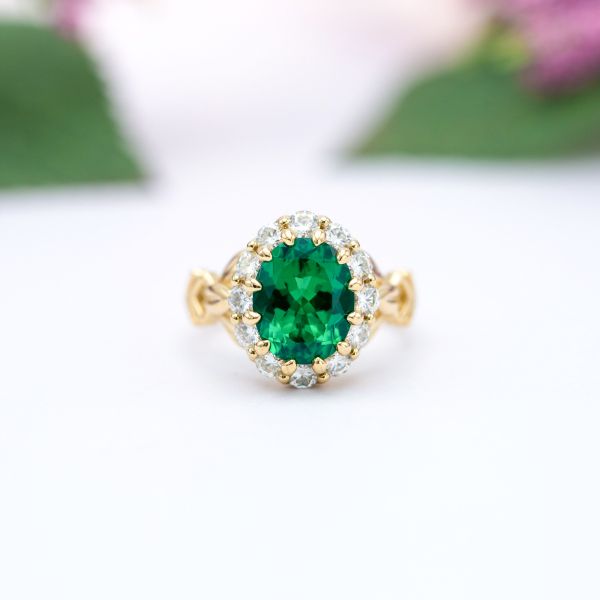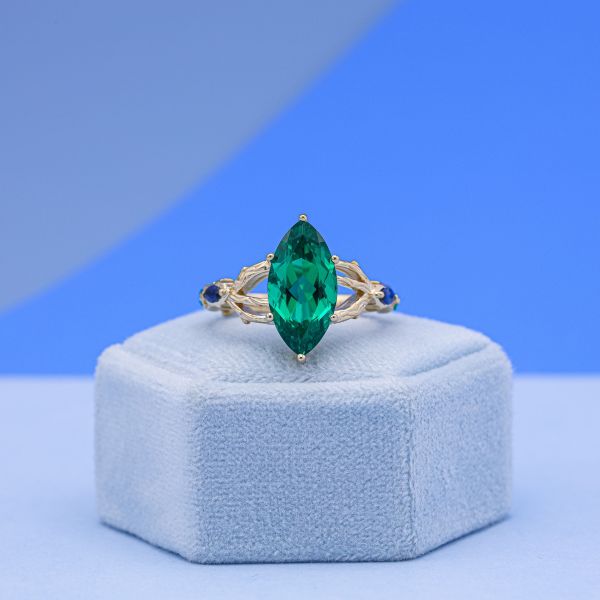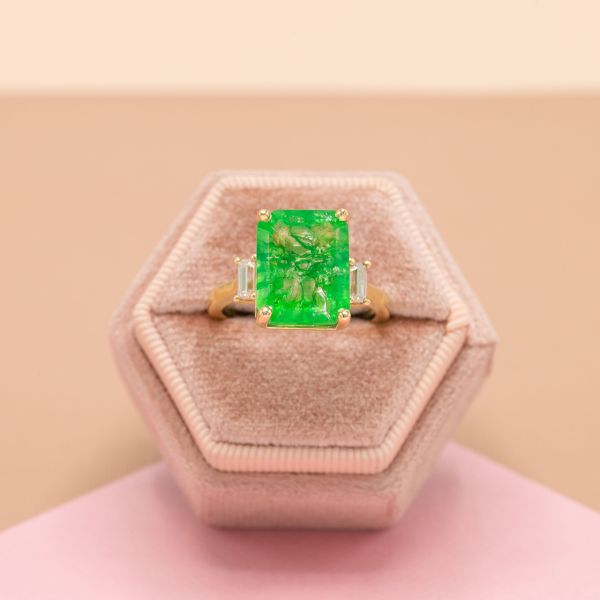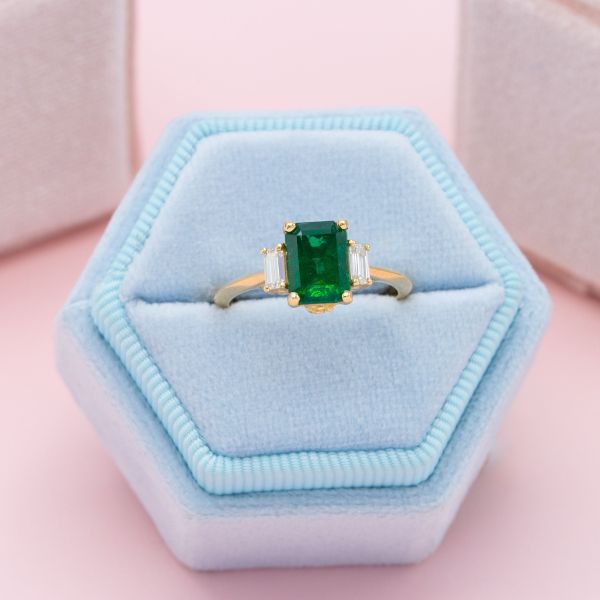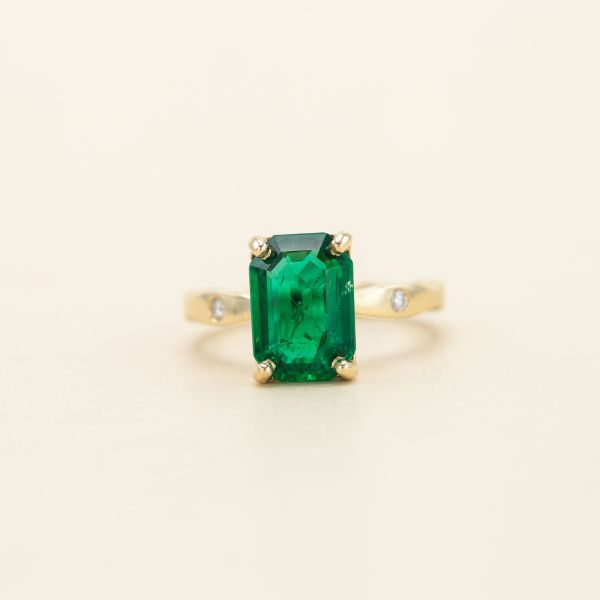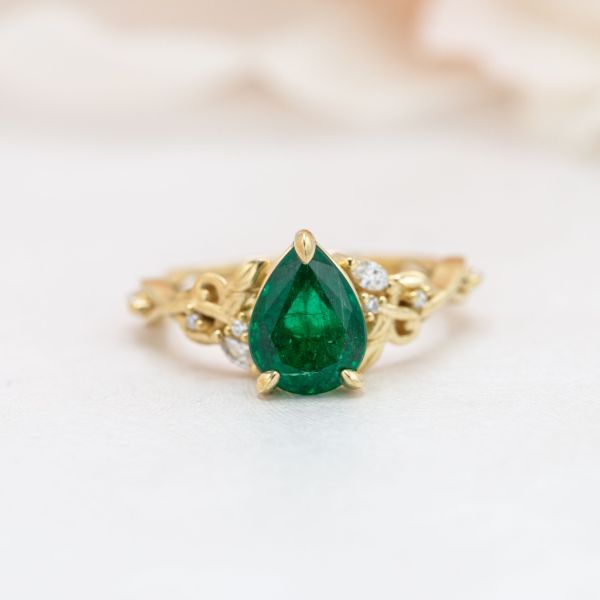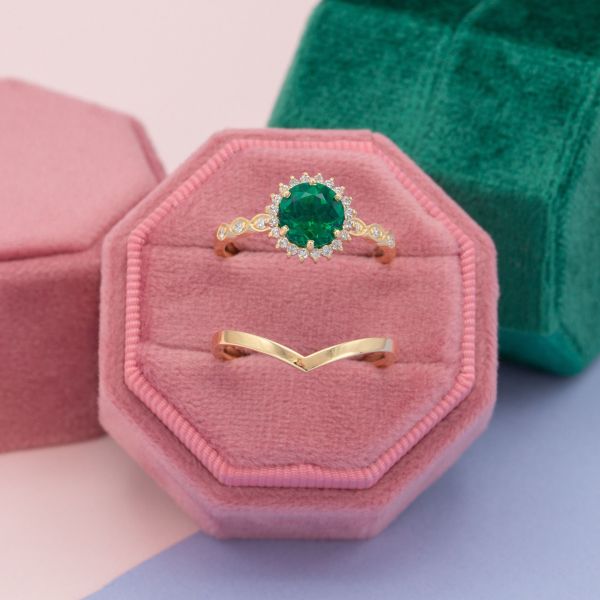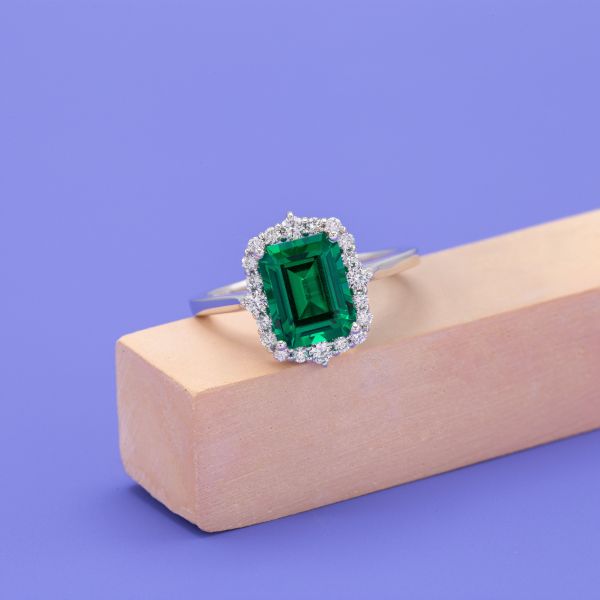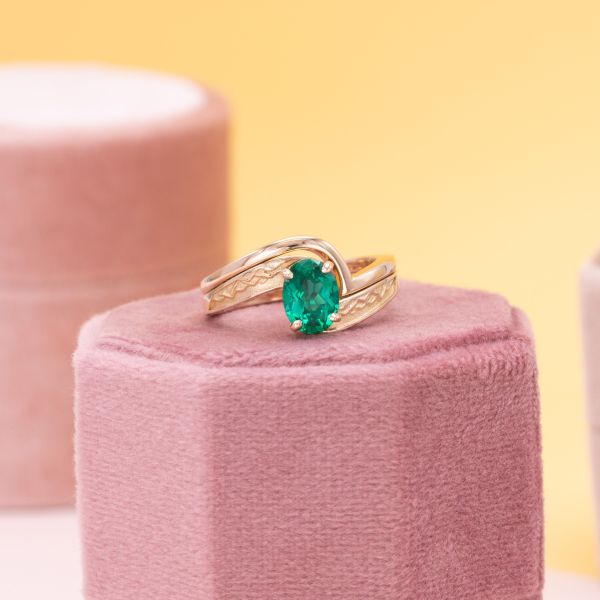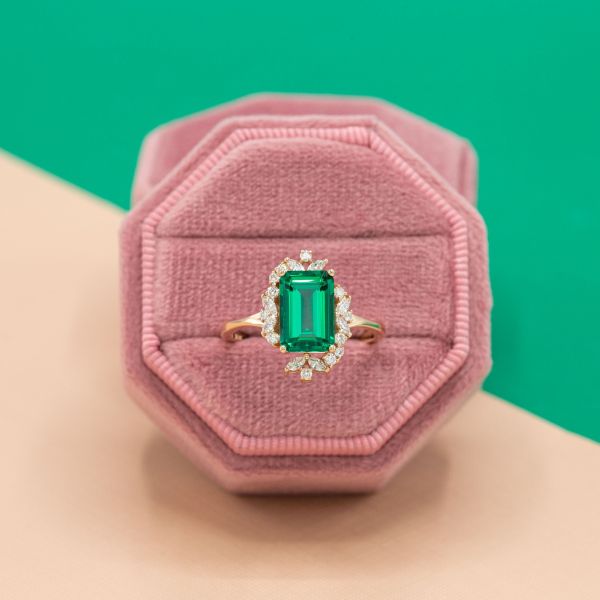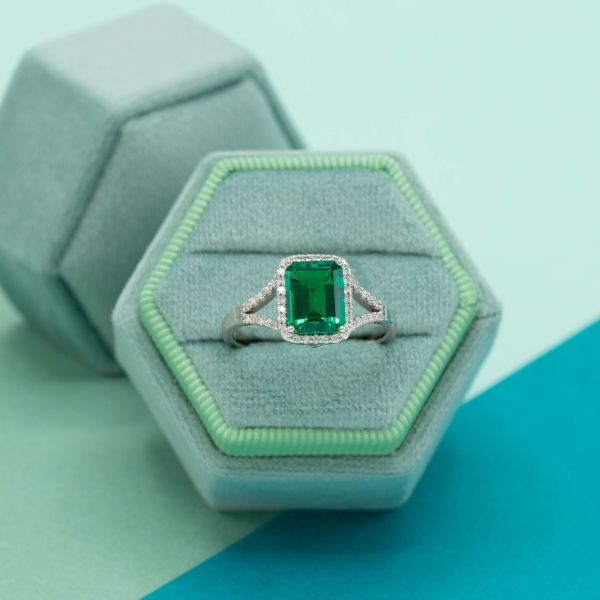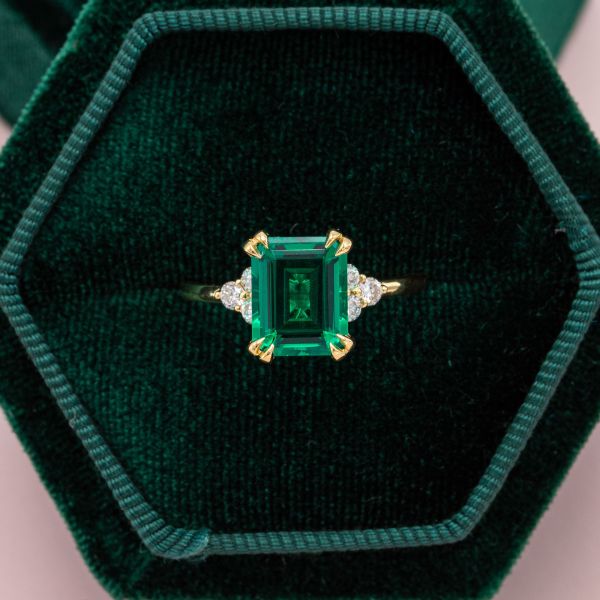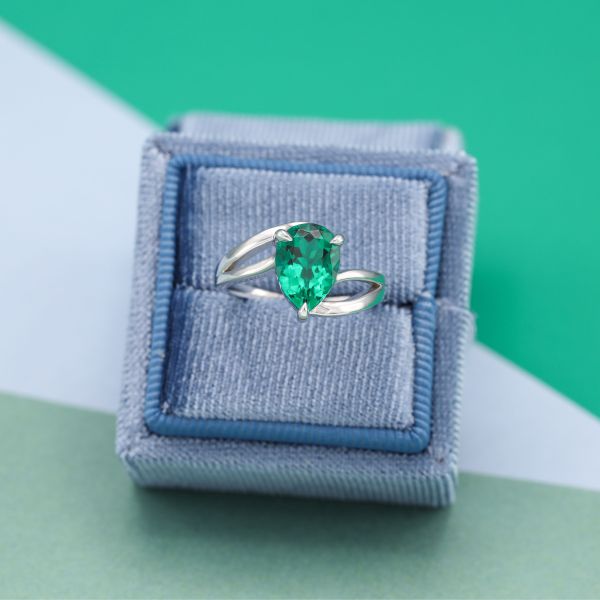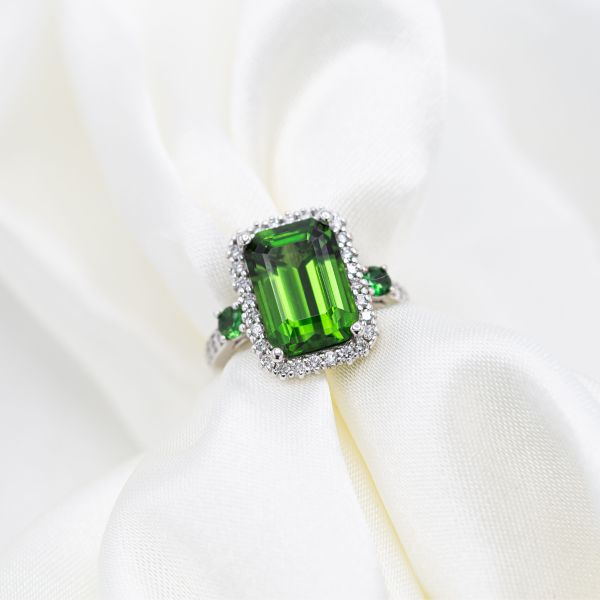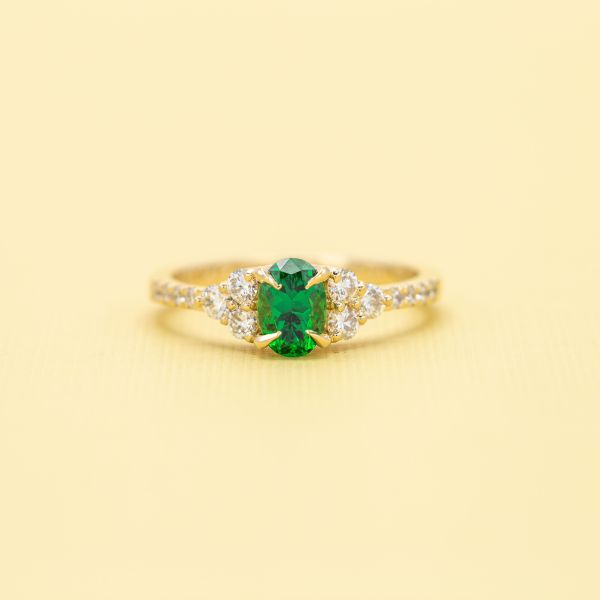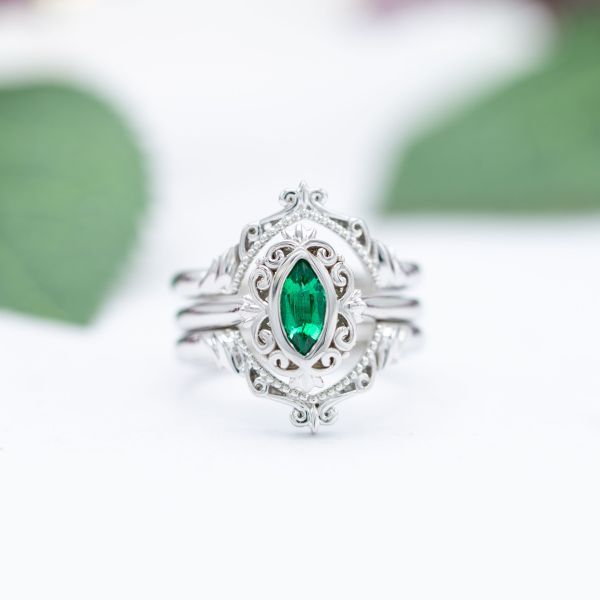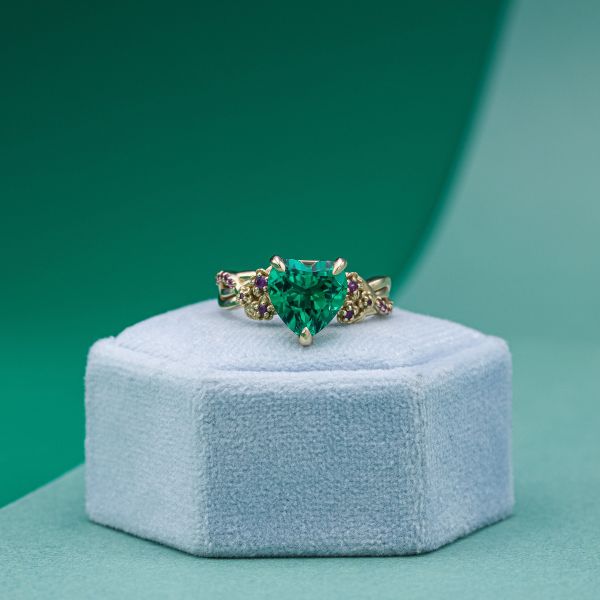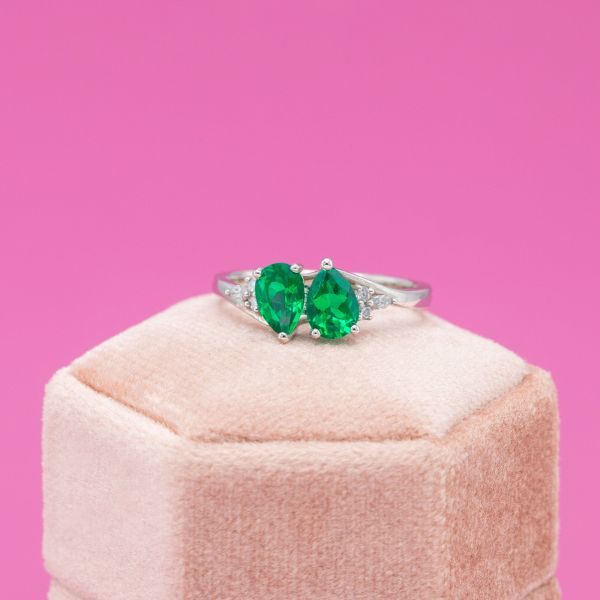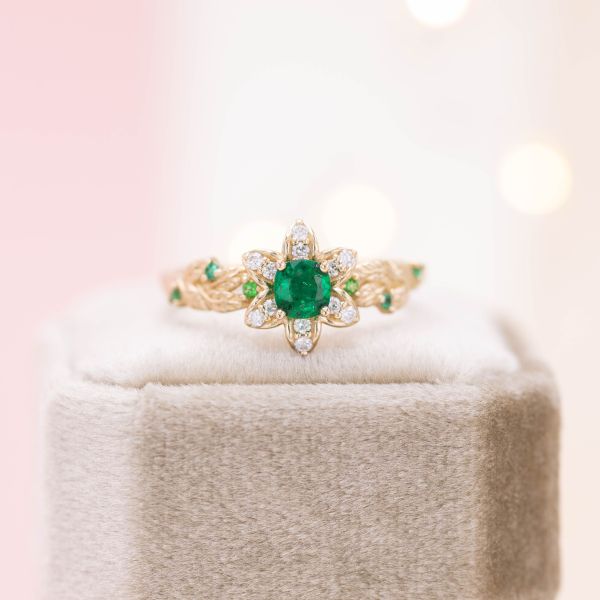Gemstone Knowledge
Is emerald a good choice?
Emerald has great name recognition and a distinct green color, but is it a good fit for an engagement ring?
Is emerald the right choice for your center stone?
Emerald is a member of the “big four” most sought out gemstones alongside diamond, ruby, and sapphire, and many couples are just green with envy over its rich color. However, you may not see emeralds in engagement jewelry as often as the other three gemstone giants, and that might be because they require wearers to handle with care. In fact, nearly all natural emeralds contain internal fractures that impact durability and require additional treatment to improve their appearance.
But please, don’t let that deter you!
Emerald is still a great choice for couples aware of its finicky personality who are ready and willing to give it the extra TLC it deserves, plus lab varieties are also a great, more durable option (yes, we’re still talking about a gem and not a puppy). Let's take a closer look at some of the reasons couples choose emeralds for their engagement rings as well as some things to keep in mind when deciding whether or not this beautiful stone is right for you.
Considerations when choosing an emerald
Their lush green color
Emerald, aquamarine, and morganite all fall into the beryl family and what (mostly) differentiates them is their color. Got a beryl that’s peachy pink because of manganese? That’s a morganite. Light blue from iron? Aquamarine. And green from chromium or vanadium? You guessed it, emerald. But emeralds considered top color are actually more than just green! That classic lush,“emerald green” we all know and love has a darker tone, strong saturation, and a subtle blue undertone, making it slightly more bluish green in nature and giving a rich depth to the stone’s color
The finest emeralds have those medium to medium-dark tones and strong to vivid saturation for a lush green display, but you can also find some stones in light, medium, or bright green variations. Some emeralds even sport a yellow undertone that brightens the stone and gives it a grassy green color reminiscent of budding plants and trees during springtime. As we already mentioned, stones with blue undertones are considered more valuable, but some couples absolutely adore the springy color of emeralds with yellow undertones. What matters most is that you love your emerald’s color, whether it’s traditional lush green, grassy green, or even mint green!
They can be fragile and require treatment
Let’s cut to the chase: having an emerald as the center of a lifelong daily wear item like an engagement ring means you’ll need to take special precautions to protect your stone. Coming in at a 7.5-8 on the Mohs hardness scale, emeralds have a good scratch resistance, meaning while you don’t want to go scraping your ring around on every hard surface you can find, it’s fairly resilient to scuffs and scratches. But alas, like everything with gemstones, durability is not black and white.
While emeralds have a good hardness and are pretty resistant to scratching, they fall a bit short in the toughness area of durability. We know what you’re thinking: toe-MAY-toe, toe-MAH-toe… isn’t that the same thing? Hardness refers to how resistant a stone is to scratching, where toughness refers to how easily a stone fractures. Still confused? Don’t worry, we’ve got you covered with an in-depth understanding of gem durability.
Emeralds may have relatively high hardness and good scratch resistance, but natural stones are fragile due to their inclusions or jardin, which is French for “garden”. But wait, how can they be hard and fragile at the same time? Well, natural emeralds tend to have surface fractures that make them more susceptible to breakage, so while you won’t scratch your emerald ring if you brush it along your wooden kitchen table, bang it against the same table hard enough and it could crack and fracture. These same imperfections, however, are responsible for their gorgeous green color. Talk about a catch-22!
Because they're prone to breaking, natural emeralds are basically all treated with clarity enhancements. Fractures like the ones we just mentioned are typically treated with oil or resin to improve the look of the stone, but they don’t last forever. Over the years, this treatment can wear down and require re-oiling or replacement to look like new, so just keep in mind that your emerald’s treatments may need to be redone at some point to keep it looking bright and sparkly. This is where lab emeralds come in, which are just as hard as natural stones without the tricky jardin—but more on that a bit later on!
Along with treatments to keep your emerald safe, a little basic TLC will help keep your stone beautiful for longer. Proper storage and avoiding contact with hard surfaces or harsh chemicals can go a long way in protecting your emerald from long-term damage, so if you have a hands-on job or enjoy hiking, exercising, swimming, or other physical hobbies you may want to keep your lifestyle in mind when deciding if an emerald is the right choice for your engagement ring.
They can be deeply meaningful
Humans have used emeralds in jewelry for thousands of years, making these green beauties one of the oldest ornamental gemstones. Some ancient cultures even tied emeralds to wisdom and memory, originally thought to give people the power to see into the future! While emeralds may not grant you precognition, they’re still a lovely symbol for the memories you will make as a married couple and the wisdom you’ll gain by experiencing life together as one.
Outside of lore and ancient history, emerald is a May birthstone as well as the traditional stone for 20th and 35th wedding anniversaries. It’s a perfect choice for a bride who is gaga for the color green, or maybe its green hue with blue undertones reminds you of all the times you got lost in your partner’s similarly colored eyes. For others, emerald is simply a unique engagement stone that sets their ring apart from the crowd, boasting that rich green hue rather than the traditional colorless sparkle of a diamond. Whatever your reason for considering an emerald, it can certainly be a sentimental choice as a center stone for your engagement ring!
They suit most settings and shapes
Emeralds have an elegant, sophisticated appeal that suits all tastes, and they can match both modern and vintage settings with ease. Their vivid green color looks decadent in warmer metals like yellow gold, but a cool toned metal like platinum can really play up those blue undertones in top color emeralds. Diamond halos and accent stones are also perfect for emerald’s vibrant color, highlighting that deep saturation with their contrasting, colorless sparkle.
While emeralds can come in many shapes and sizes, common cuts include round, pear, oval, and square. However, it’s no surprise that the most common cut is…drumroll, please…an emerald cut! The cut was named after the green stone given the fact that it’s the most chosen shape for emeralds. Natural emerald is a long, hexagonal crystal in its rough form, so the emerald cut is ideal for producing less waste during the cutting process and is a great way to showcase emerald’s lively color. Plus, the emerald cut is versatile and can suit a modern solitaire design as well as an ornate vintage setting thanks to its neutral shape and sparkle.
Although less common, emeralds are also great for cabochons: unfaceted, smooth stones that offer a deeper look at emerald’s color. These domed designs give you an up close and personal look at the lush color of an emerald, and they usually have more imperfections intact that make them look dreamy and mystical–ideal for a floral or nature-inspired engagement ring!
Alternatives
Lab emeralds
While not an alternative to emeralds, because it is one, lab emeralds are an awesome variation of this stone to consider if you’re concerned about durability. Just like lab and natural diamonds, lab emeralds are chemically the same as their mined counterparts but are produced in a controlled lab environment, so they have all of the same gorgeous green appeal with enhanced clarity and durability at a more reasonable price. Seems like a win-win, right?
Lab-created emeralds are just as hard as natural stones but lack the fractures and inclusions, so they’re generally more suitable for daily wear in an engagement ring. At CustomMade, we use lab emeralds that are grown and selected for “top color”, so you get a more durable stone with an exceptional green hue for a fraction of the price! Given all of this information, many of our couples opt for lab emeralds, and we’ve already discussed the differences between lab and natural emeralds in more detail so you can make an informed decision.
Chrome tourmaline
Tourmaline–specifically chrome tourmaline–is another green alternative for emeralds. Chrome tourmaline has traces of chromium for color closer to that of emeralds, and it offers good saturation and a striking green flash in its sparkle. Chrome tourmaline does tend to be slightly less saturated when compared to emeralds, and you’ll probably encounter plenty of stones with a grassy green hue. That doesn’t mean there aren’t chrome tourmalines with those bluish green emerald hues–they’re just a bit harder to find!
While essentially matching emerald on the Mohs hardness scale (7-7.5) for scratch resistance, chrome tourmalines can handle daily wear a little better than emeralds since top-quality stones don’t have as many inclusions that allow for easy fracturing. What’s more, they’re often eye-clean, so you won’t have to worry about visible inclusions and can focus on that green color and sparkle! Just be mindful if you’re looking for larger stones: chrome tourmaline’s price point jumps after 1 carat, but it’s still usually more affordable than natural emerald if you can find the right stone!
Tsavorite garnet
Another solid alternative, tsavorite garnet is incredibly sparkly and effectively mimics emerald’s green hues. Named after Kenya’s Tsavo National Park (one of two places it was first discovered), tsavorite quickly rose in popularity when jewelry giant Tiffany & Co. launched a marketing campaign in 1974 to bring recognition to this gorgeous green stone. Like emerald, tsavorite also carries traces of vanadium and sometimes chromium to produce a similar rich green color, except tsavorite has a higher dispersion rate and more brilliance for a bit more sparkle. Tsavorite garnet has a Mohs hardness scale rating of 6.5 to 7.5, so you can still place this stone at the center of your engagement ring if you commit to taking good care of it. While it’s rare to find stones over two carats, there are plenty available in the 1 carat range.
Choosing an emerald engagement stone
Green: the color of summer trees, Slytherins, and cold, hard cash! It’s somehow both soothing and invigorating at the same time, and many couples are drawn to emerald’s vibrant green hue. However, natural stones do require some extra care to maintain their radiant appeal, so you may want to take that into consideration if you live a super active lifestyle. But if that little extra TLC and love for green fits into what you’re looking for, emerald might just be the perfect stone for you!
About CustomMade
CustomMade designs and creates one-of-a-kind, custom engagement rings and fine jewelry. Each piece we create is inspired by you, designed for you, and made just for you.
